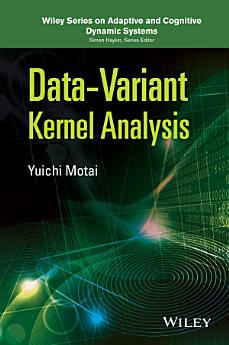Data-Variant Kernel Analysis
এপ্ৰিল ২০১৫ · John Wiley & Sons
ইবুক
256
পৃষ্ঠা
reportমূল্যাংকন আৰু পৰ্যালোচনা সত্যাপন কৰা হোৱা নাই অধিক জানক
এই ইবুকখনৰ বিষয়ে
Describes and discusses the variants of kernel analysis methods for data types that have been intensely studied in recent years
This book covers kernel analysis topics ranging from the fundamental theory of kernel functions to its applications. The book surveys the current status, popular trends, and developments in kernel analysis studies. The author discusses multiple kernel learning algorithms and how to choose the appropriate kernels during the learning phase. Data-Variant Kernel Analysis is a new pattern analysis framework for different types of data configurations. The chapters include data formations of offline, distributed, online, cloud, and longitudinal data, used for kernel analysis to classify and predict future state.
Data-Variant Kernel Analysis:
This book covers kernel analysis topics ranging from the fundamental theory of kernel functions to its applications. The book surveys the current status, popular trends, and developments in kernel analysis studies. The author discusses multiple kernel learning algorithms and how to choose the appropriate kernels during the learning phase. Data-Variant Kernel Analysis is a new pattern analysis framework for different types of data configurations. The chapters include data formations of offline, distributed, online, cloud, and longitudinal data, used for kernel analysis to classify and predict future state.
Data-Variant Kernel Analysis:
- Surveys the kernel analysis in the traditionally developed machine learning techniques, such as Neural Networks (NN), Support Vector Machines (SVM), and Principal Component Analysis (PCA)
- Develops group kernel analysis with the distributed databases to compare speed and memory usages
- Explores the possibility of real-time processes by synthesizing offline and online databases
- Applies the assembled databases to compare cloud computing environments
- Examines the prediction of longitudinal data with time-sequential configurations
Data-Variant Kernel Analysis is a detailed reference for graduate students as well as electrical and computer engineers interested in pattern analysis and its application in colon cancer detection.
লিখকৰ বিষয়ে
YUICHI MOTAI, Ph.D., is an Associate Professor of Electrical and Computer Engineering at the Virginia Commonwealth University, Richmond, Virginia. He received his Ph.D. with the Robot Vision Laboratory in the School of Electrical and Computer Engineering, Purdue University, West Lafayette, Indiana in 2002.
এই ইবুকখনক মূল্যাংকন কৰক
আমাক আপোনাৰ মতামত জনাওক।
পঢ়াৰ নির্দেশাৱলী
স্মাৰ্টফ’ন আৰু টেবলেট
Android আৰু iPad/iPhoneৰ বাবে Google Play Books এপটো ইনষ্টল কৰক। ই স্বয়ংক্রিয়ভাৱে আপোনাৰ একাউণ্টৰ সৈতে ছিংক হয় আৰু আপুনি য'তে নাথাকক ত'তেই কোনো অডিঅ'বুক অনলাইন বা অফলাইনত শুনিবলৈ সুবিধা দিয়ে।
লেপটপ আৰু কম্পিউটাৰ
আপুনি কম্পিউটাৰৰ ৱেব ব্রাউজাৰ ব্যৱহাৰ কৰি Google Playত কিনা অডিঅ'বুকসমূহ শুনিব পাৰে।
ই-ৰীডাৰ আৰু অন্য ডিভাইচ
Kobo eReadersৰ দৰে ই-চিয়াঁহীৰ ডিভাইচসমূহত পঢ়িবলৈ, আপুনি এটা ফাইল ডাউনল’ড কৰি সেইটো আপোনাৰ ডিভাইচলৈ স্থানান্তৰণ কৰিব লাগিব। সমৰ্থিত ই-ৰিডাৰলৈ ফাইলটো কেনেকৈ স্থানান্তৰ কৰিব জানিবলৈ সহায় কেন্দ্ৰত থকা সবিশেষ নিৰ্দেশাৱলী চাওক।





